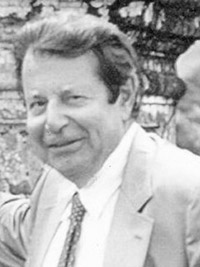In Memoriam: Mario W. Overhoff
1928-2005
by Morgan Cox, CHP

The world of radiation detection instrumentation and instrumentation standards lost an expert, colleague, and friend when Mario Overhoff passed away on 23 December 2005. He died unexpectedly in Cincinnati following a brief illness.
Mario was born in Vienna, Austria, on 12 November 1928 and grew up in England and Canada during and following World War II. He received his bachelorÙs degree from McGill University and his masterÙs and doctorate magna cum laude in science and electrical engineering at Laval University. During college he began his lifelong love of flying by becoming a Canadian champion sailglider. He recently merged his skills in engineering and interest in flying by designing and building his own airplane. He had instrument and multiengine ratings for private aircraft. He had many thousands of hours piloting twin-engine aircraft.
After his college years and while visiting Vienna, he met and married the love of his life, Isabel, Baroness von Buol-Wischenau, and settled in Canada. Within two years he accepted a position as technical director of a company in Columbus, Ohio. Four years later he and his family moved to Cincinnati where, in the true American tradition, he founded Overhoff and Associates in the basement of his home.
His company is now named Overhoff Technology Corporation and is recognized worldwide as a manufacturer of high-quality radiation detection instrumentation.
One of the most exciting periods of his long career was in the late 1960s when he was chief electrical and electronics engineer for the Space Research Institute in Highwater, Quebec. The main project, titled “Harp,” was engaged in space research using intercontinental gun-launched vehicles. Mario reported directly to Dr. Gerry V. Bull, famous for gun-launched ballistic missiles. Because of lack of funding and political differences between the Canadian and U.S. governments this project was closed. Bull was later mysteriously assassinated while developing the “super-gun” made famous in a recent movie.
MarioÙs career spanned some 50-plus years devoted to research, development, and manufacturing of electronic instrumentation for measurement and process control. His technical expertise extended into radar telemetry, guidance for intercontinental ballistic missiles, pseudo random-coded sonar systems for submarine detection, chemical sensor technology, beta gauging, infrared, and microwave gauging for process control of paper and plastic products and aircraft instrumentation.
During the last 35 years Mario launched an independent company that has designed, manufactured, marketed, and serviced numerous health physics instruments. These include tritium monitors of various types, monitors for radioactive noble gases, monitors for airborne plutonium, and portable alpha, beta, gamma, and neutron detectors. He has served with distinction on several American National Standards Institute (ANSI) N42 standards committees, including ANSI N42.33 for portable radiation detectors for Homeland Security Department (DHS) applications and ANSI N42.47 being developed for dosimeters for the DHS.
He was an active member of a number of technical organizations including the Health Physics Society, the American Nuclear Society, the Institute of Electrical and Electronics Engineers, Inc., ANSI N42, the Aircraft Owners and Pilots Association, and the Experimental Aircraft Association. He was also a proud member of Rotary International.
Mario knew more about analog electrical technology than anyone else I have ever encountered.
His family, friends, colleagues, and coworkers remember Mario as a warm and caring gentleman who always saw the best in people. He was loved for his warmth, friendliness, encouragement, and some very bad jokes.
He is survived by his widow, Isabel; daughters Alexandra and Kathryn; a sister, Angela Countess von Hartig of Vienna; many friends and colleagues; and his pet felines. May he rest in peace.



